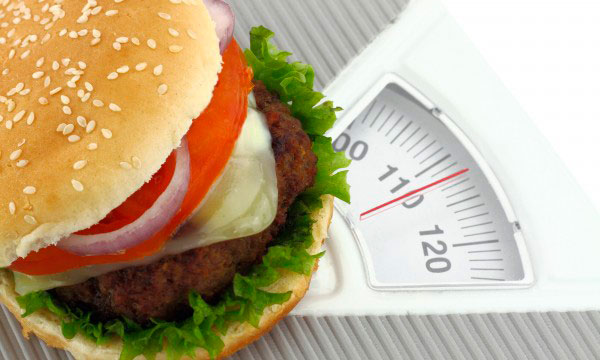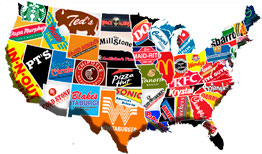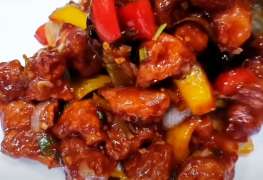In some areas, "fast" is a good thing. When it comes to improving your running or walking pace, completing a dreaded task or even losing weight (safely, of course)—well, the faster, the better. Fast traffic, fast money, fast meetings: all good.
But when it comes to fast food? Not so much.
We've all been in that situation when, strapped for time or lagging in energy, we give into the tempting convenience, quickness and maybe even the crave-worthy taste of a drive-thru meal. But the short-term rewards are quickly eclipsed by the nagging guilt of consuming food (and we use that term loosely) that, in most cases, provides little to no nutritive benefit and exceeds our allotment of calories, saturated fat, sodium and sugar.

Let's face it: There's nothing fun about entering a Big Mac and fries into your Nutrition Tracker.
That said, the occasional window pickup doesn't have to completely derail your progress. Summer Yule, MS, RDN, says the Academy of Nutrition and Dietetics promotes a "total diet approach" to nutrition, where—barring certain medical contraindications—all foods can fit. "What this means is that favorite meals from fast food restaurants do not need to be completely avoided, but they should not make up the bulk of a person's typical dietary pattern, and they should be consumed in moderate portions," Yule says.
And while fast food isn't ideal, on those (hopefully) rare events when it's the only option, some choices are smarter than others.
Just say "no" to super-sized.
It may seem obvious, but sticking to the smallest portion is a surefire way to save a lot of calories, sodium and saturated fat. Most of today's fast food restaurants make it all too easy to bump up your order to gargantuan proportions.
"There's always the ability to supersize anything on the menu—just say the word and you instantly triple your fat and calories," warns Cindy Brehse, owner of Fitness With Cindy. "Avoid the gigantic portions, like triple-decker burgers and gallon-sized sodas, and stick to regular-sized menu options to keep your fat and calorie counts manageable."
And if all else fails, the simplest way to ensure reasonable portions is to tap into your inner child and order from the kid's menu.
Avoid anything fried.
As a general rule, steer clear of anything fried, battered or breaded, such as french fries, crispy chicken sandwiches and chicken nuggets. "These items will be more processed with additives like high-sodium preservatives, sugars and highly processed saturated fats," warns Staci Gulbin, MS, MEd, RD, LDN from Light Track Nutrition.
In most cases, a grilled or non-breaded option is available. For example, Chick-fil-A's grilled chicken nuggets only contain 210 calories, compared to 390 calories for the breaded version. And at Steak 'n Shake, the grilled chicken sandwich has 370 calories, while the spicy breaded chicken sandwich will run you 580 calories.
Check the nutrition info.
Most fast food chains post nutritional information (or at least a calorie count) right on their drive-thru menus, making it easy to compare and choose the most diet-friendly options.
Don't have the time or the eyesight to eyeball the small print from your car window? Yule suggests checking online ahead of time. Not only is it easier to peruse, the online nutrition information will also include things like sodium and saturated fat content, which are generally not on the menu board.
You just might be surprised by what the numbers reveal. For instance, Yule says, according to the McDonald's website, the small fries only contain 160 milligrams of sodium (7 percent daily value). "Many people would probably never guess that the fries are considerably lower in sodium than the grilled chicken sandwich, which has 1120 milligrams of sodium at 47 percent daily value," she says.
Be smart about salads.
It may seem like a veggie-based salad is a can't-miss choice, but when it's loaded with dressing, cheese and croutons, it can easily rival a loaded cheeseburger in terms of fat and calories.
"If the fresh veggies aren't prominent, then you could be eating more calories and fat than you thought," warn Kim and Kalee Sorey from Sorey Fitness. "For example, the Zaxby's Zensation Zalad has 1,165 calories—almost a day's worth of food depending on your height and weight."
Always ask to have the dressing on the side so you can control your intake, and opt for vinegar/oil-based dressings instead of the creamier, higher-fat options. Gulbin also suggests avoiding breaded meats and loading up with non-starchy vegetables, like tomatoes, cucumbers, onions and peppers. Opt out of croutons, instead sprinkling on some fiber-rich slivered almonds, peanuts or chia seeds from home.
Look for healthier fare.
If you have a favorite fast food restaurant, Yule suggests choosing some of the better-for-you options as go-to items that you can fall back on when you don't have time to plan meals. "For example, in the summer, Panera offers the Strawberry Poppyseed Chicken Salad," she notes. "It is under 400 calories for a whole-sized salad, the sodium and fat content are reasonable, and it comes with a light poppyseed dressing."
Brehse has a few healthier fast food favorites, like Wendy's chili and apple pecan chicken salad, and Chick-fil-A's grilled sandwiches and salads. "A healthy diet leaves room to splurge every now and then," she says. "It's about portion control and not gorging yourself on a gigantic bucket of fries just because they're part of some meal deal."
And when you get the inevitable question, "Do you want fries with that?", ask what nutritious alternatives are on offer. Most chain restaurants now offer at least a few healthier sides. At Wendy's, you can choose a plain baked potato, apple slices or a small salad. Chick-fil-A offers mixed fruit cups, Greek yogurt and a "superfood" side that blends broccolini, kale, sour cherries and roasted nuts. And at Steak 'n Shake, you can bypass fries in favor of vegetable soup, cottage cheese or baked beans.
Skip the sugar-sweetened soda.
A large Coca-Cola from Wendy's might only set you back a couple of bucks, but it will also cost you a whopping 400 calories—nearly a quarter of the average recommended calorie intake for the entire day. On top of that, Gulbin warns that fast food restaurants often serve many beverages with high-fructose corn syrup and added sweeteners or dyes that can be harmful to your health, especially when consumed in excess.
Although diet soda eliminates the calories, it also contains artificial sweeteners, which some studies suggest could cause an increased craving for more sweet foods. Your best bet is to skip the soda altogether and choose water or unsweetened iced tea.
Choose the right kind of bread.
When ordering something that contains bread, always choose the whole-grain option when available. Or better yet, as Gulbin points out, some fast food restaurants offer the option of getting burgers and sandwiches in lettuce wraps instead of buns, which can save on calories and refined carbohydrates. And if they don't, nutritionist Donna P. Hetrick suggests removing the bun and requesting extra lettuce leaves to create your own wrap.
Scale back on the sauces.
While you can still enjoy your favorite condiments and dressings, be careful not to overdo it. Request them on the side and add them in small amounts. And when ordering a burger, Hetrick recommends selecting mustard or salsa over ketchup and mayonnaise to reduce sugar and calorie intake. Even better, choose leaf lettuce, tomato, onion and pickles as toppings instead of the more calorie-heavy cheese, mayonnaise and bacon.








Leave a comment